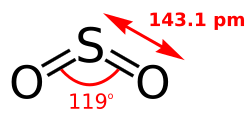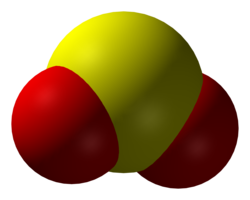Sulfur dioxide
Sulfur dioxide (also sulphur dioxide) is the chemical compound with the formula SO2. It is a gas. It smells like burnt matches or rotten eggs. It can also cause suffocation. Sulfur dioxide is produced by volcanoes and in various industrial processes. It is also used to protect wine from oxygen and bacteria. It can be produced by burning sulfur. It dissolves in water to produce sulfurous acid. It can be oxidized to trioxide, which is dissolved in sulfuric acid to make more sulfuric acid. It is used to make sulfites.
| Sulfur dioxide | |
|---|---|

| |

| |
| IUPAC name | Sulfur dioxide |
| Other names | Sulfurous anhydride Sulfur(IV) oxide |
| Identifiers | |
| CAS number | |
| PubChem | |
| EC number | 231-195-2 |
| KEGG | D05961 |
| MeSH | |
| ChEBI | CHEBI:18422 |
| RTECS number | WS4550000 |
| SMILES | O=S=O |
| Beilstein Reference | 3535237 |
| Gmelin Reference | 1443 |
| Properties | |
| Molecular formula | SO2 |
| Molar mass | 64.066 g mol−1 |
| Appearance | Colorless gas |
| Odor | Pungent; similar to a just-struck match[1] |
| Density | 2.6288 kg m−3 |
| Melting point |
-72 °C, 201 K, -98 °F |
| Boiling point | |
| Solubility in water | 94 g/L[2] forms sulfurous acid |
| Vapor pressure | 237.2 kPa |
| Acidity (pKa) | 1.81 |
| Basicity (pKb) | 12.19 |
| −18.2·10−6 cm3/mol | |
| Viscosity | 0.403 cP (at 0 °C) |
| Structure | |
| C2v | |
| Coordination geometry |
Digonal |
| Molecular shape | Dihedral |
| Dipole moment | 1.62 D |
| Thermochemistry | |
| Std enthalpy of formation ΔfH |
−296.81 kJ mol−1 |
| Standard molar entropy S |
248.223 J K−1 mol−1 |
| Hazards | |
| NFPA 704 |
|
| U.S. Permissible exposure limit (PEL) |
TWA 5 ppm (13 mg/m3) |
| Except where noted otherwise, data are given for materials in their standard state (at 25 °C, 100 kPa) | |
Sulfur Dioxide Media
An experiment showing burning of sulfur in oxygen. A flow-chamber joined to a gas washing bottle (filled with a solution of methyl orange) is being used. The product is sulfur dioxide (SO2) with some traces of sulfur trioxide (SO3). The "smoke" that exits the gas washing bottle is, in fact, a sulfuric acid fog generated in the reaction.
US Geological Survey volunteer tests for sulfur dioxide after the 2018 lower Puna eruption.
The effect of major volcanic eruptions on sulfate aerosol concentrations and chemical reactions in the atmosphere
Acid rain-damaged forest in Europe's Black Triangle
Early 2010s estimates of past and future anthropogenic global sulfur dioxide emissions, including the Representative Concentration Pathways. While no climate change scenario may reach Maximum Feasible Reductions (MFRs), all assume steep declines from today's levels. By 2019, sulfate emission reductions were confirmed to proceed at a very fast rate.
The extent to which physical factors in the atmosphere or on land affect climate change, including the cooling provided by sulfate aerosols and the dimming they cause. The large error bar shows that there are still substantial unresolved uncertainties.
Sources
- ↑ Sulfur dioxide Archived 2019-12-30 at the Wayback Machine, U.S. National Library of Medicine
- ↑ Lide, David R., ed. (2006). CRC Handbook of Chemistry and Physics (87th ed.). Boca Raton, FL: CRC Press. ISBN 0-8493-0487-3.
| Wikimedia Commons has media related to Lua error in Module:Commons_link at line 62: attempt to index field 'wikibase' (a nil value).. |







